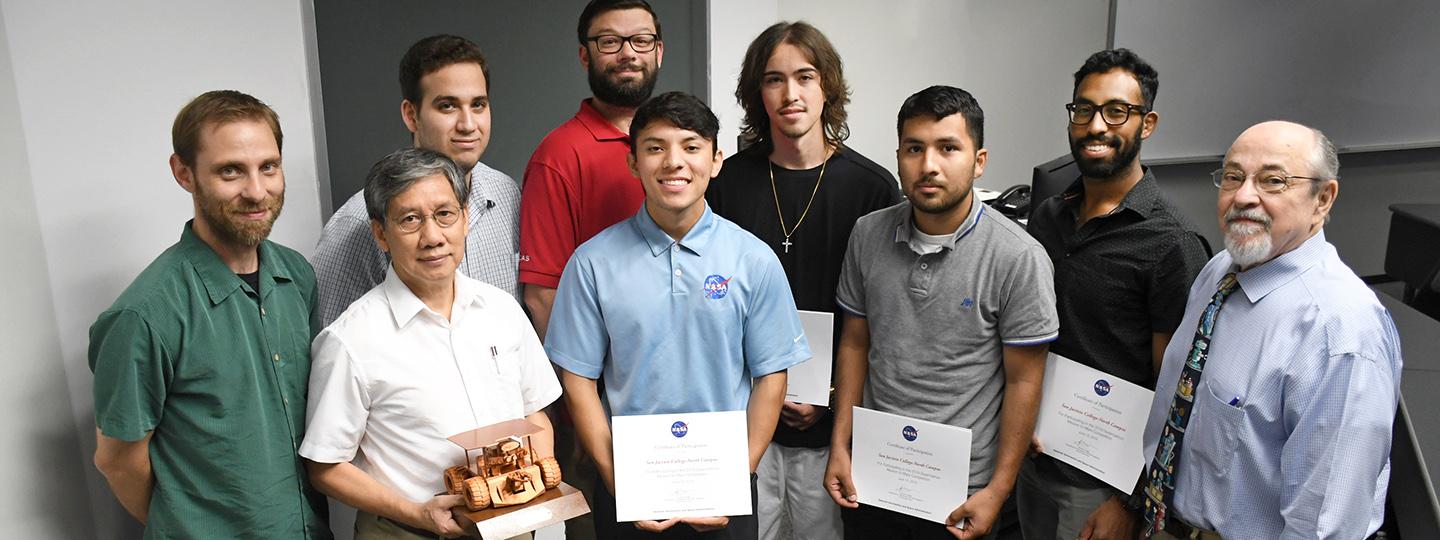NASA Swarmathon robotics team builds transfer, career opportunities

For San Jacinto College students, the NASA Swarmathon competition is not just about gaining advanced technical skills or racking up awards. It's about a pipeline to transfer, internship, and employment opportunities.
For the past four years, the College and the University of Houston-Clear Lake have partnered in the robotics space exploration competition, merging technical and programming expertise to create real-world collaboration for students from freshmen to seniors.
This spring, the joint team of about 20 students placed first in Mission to Mars and third in physical competition categories at the annual event at Kennedy Space Center.
"We shine as one of the strongest community college/university partnerships in the nation and have created a clear pathway from basic education to advanced technical fields," San Jac's Nate Wiggins, NASA Swarmathon team co-leader, said.
Wiggins, North Campus math and engineering professor and STEM coordinator, coaches the team along with Dr. Luong Nguyen, UHCL assistant professor of computer engineering.
Their goal? Getting students immersed in all aspects of hardware, software, and testing for learning potential and resume experience.
Envisioning tomorrow's space technology
NASA Swarmathon engages undergraduate students in developing and testing robotic algorithms (processes followed in problem-solving operations) for swarm technology that could be used in NASA's future exploration.
Instead of sending one multimillion-dollar robot on missions, NASA could send a swarm of smaller, less expensive robots to collaborate on tasks, increasing productivity while lowering financial risk.
NASA Swarmathon is organized by the Moses Biological Computation Lab at the University of New Mexico and funded by the NASA Minority University Research Program. The event involves three different competitions: physical, virtual, and Mission to Mars.
Physical teams receive kits to build "Swarmies" and write code to run the small test robots autonomously in an unknown environment with randomly-placed obstacles.
Using algorithms inspired by foraging ants' behavior, the Swarmies gather and return these objects to a central base — just as robots might collect useful materials from Mars' surface to be used by astronauts on the red planet.
Teams in the virtual competition run their search code in a simulation interface named Gazebo. Virtual teams develop novel distributed search and communication algorithms for Swarmies running in this Gazebo simulation environment.
In the Mission to Mars competition judged by NASA engineers and educators, students imagine a task to perform on Mars, then write the code to make it happen.
This year, San Jac and UHCL teammates placed first in Mission to Mars. For their winning entry, students created a video showcasing a Mars rover mission in which Swarmies collect soil samples to advance research of extraterrestrial plant cultivation for renewable food sources.
Teaming for long-term success
The Swarmathon institutional partnership is a win-win. San Jac brings strong welding and drafting resources to the table, while UHCL boasts faculty who wrote the books on Robot Operating System programming.
"Our College has hardware skills and motivated students. UHCL has seniors with motivation on a senior project. Together, we have enough resources for constant robot maintenance, testing, and coding," Wiggins said. "Since we have a pipeline, this also brings experience and direction to students who want to gain skills since the learning curve is so steep."
Through NASA Swarmathon, a San Jac freshman in Intro to Engineering can collaborate on a project with a senior design group, getting advice from seasoned students while interacting with university faculty.
Engineering student Richard Castaneda was one of these freshmen. Intrigued by the collaborative robotics project, he decided to join the team.
"By participating, I learned how to become a better learner, work with others, stay organized, and be a better researcher. It put everything into perspective," Castaneda said.
Thanks to his hard work on the team and in the classroom, Castaneda won the STEM-based Texas Space Grant Consortium transfer award and ultimately looks forward to pursuing a mechanical engineering degree at UHCL.
In addition, San Jac students acquire industry skills in C++, Linux, GitHub, ROS, Python, Gazebo, SolidWorks, Blender, and Autodesk and gain internship exposure.
"We had two students attend the Massachusetts Institute of Technology with Google for a specialized workshop, and both had internships within a month at Johnson Space Center," Wiggins said.
The San Jac/UHCL NASA Swarmathon partnership is funded through a National Science Foundation Bridges to STEM Careers grant, in which UHCL serves as the lead institution and the College as a collaborator.
According to Wiggins, collaborative projects like this have boosted enrollment in math and engineering programs at both institutions, and UHCL now ranks as the College's top engineering transfer partner.
For San Jac and UHCL students, it's not enough to maneuver robots on Mars — it's about making the leap from community college to university and beyond.
